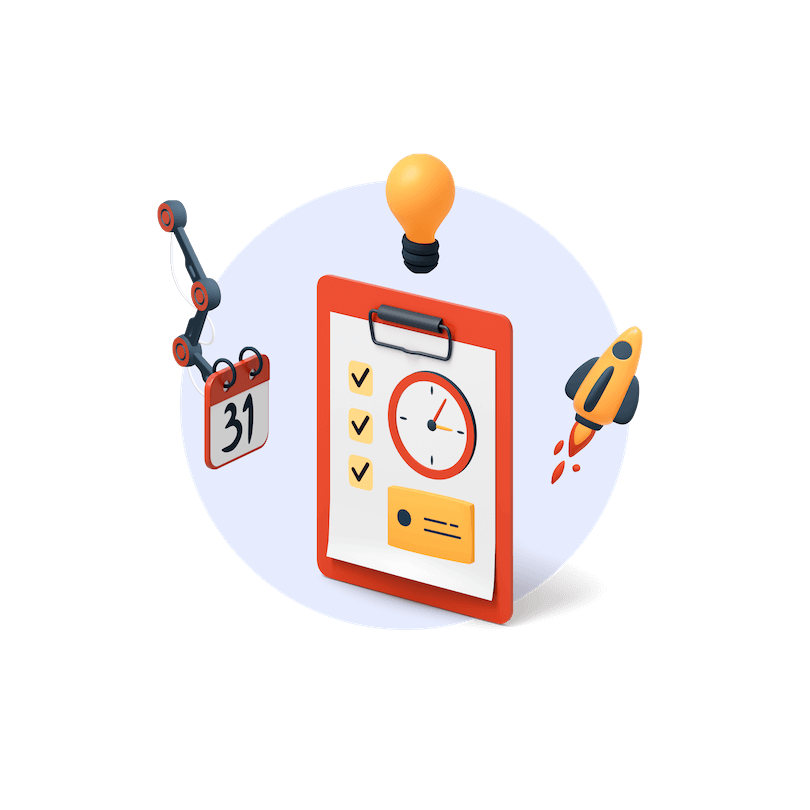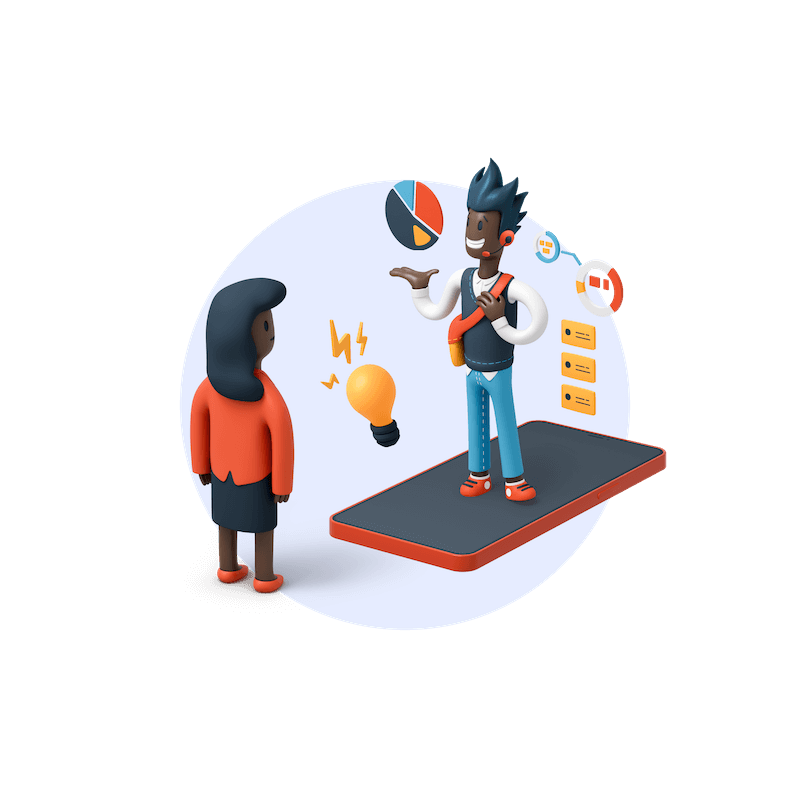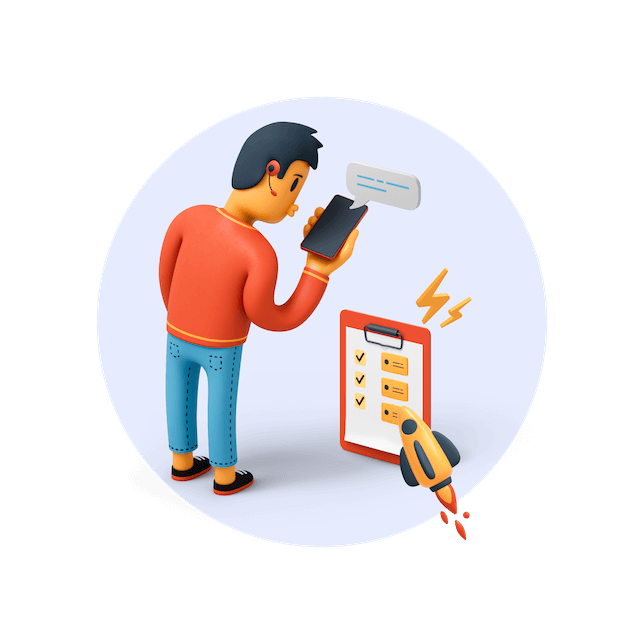Time is money, and that’s why tracking employee work hours is essential for any successful business. But before you go breaking the bank on those fancy time tracking software programs, have you considered open source options? Whether you’re a small start-up trying to keep expenditures low or a freelancer looking for more personalized flexibility, open source time tracking software can provide the solutions you need without draining your budget. Not only does it measure productivity and assist in payroll management, but open source software allows you to tailor the program to fit the unique needs of your business.
Open source software is available for free, without a commercial license, and there are countless options to assist with time tracking. Many open source options have user-friendly interfaces, and customizable features, and can integrate with other software programs used in your business. Best of all, using open source tools helps support the global community of developers who continue to create and improve upon these valuable resources.
Time tracking is an important part of managing your team. But not just any time tracker will do–you need something easy-to use, flexible and versatile so that everyone on the floor knows where their hours go! Quidlo comes with another interesting article where we’ll provide a rundown of the top open source software solutions so you can make an informed decision. Here, we’ll compare and contrast commercial time tracking software with its open source counterpart. In addition, we’ll discuss how to more accurately keep track of time and the advantages and disadvantages of using open source software. Lets get to the basics first!
Table of Contents
What is an Open Source Time Tracking Software?
The term “open source” was officially coined in 1998, but the idea behind it had already been practiced by many in the tech industry. In modern times, open source principles have been applied to the world of software development. By publicly sharing access to code and allowing for collaboration on projects, developers are able to create high-quality, innovative software solutions more efficiently. The current landscape of FOSS includes open source time tracking software.
From freelancers and small business owners to large corporations, accurately tracking work hours is crucial for productivity and success. Fortunately, open-source time tracking software can make this task easier and more cost-effective. The term “open source” refers to software that can be accessed, modified, and distributed by anyone. These tools often have customizable features and options for integrating with other software applications, making them potentially more flexible than closed source options.
Not only does it allow for simple sign-in/out functionality, but it also offers options for monitoring overall productivity during work hours. For businesses and communities, it can provide valuable insight into employee/member work hours. Plus, being able to modify and improve the software as a community ensures a constant stream of updates and enhancements. In short, open-source time tracking software is a smart solution for anyone looking to increase efficiency and accurately track work hours.
What are the Most Important Features of Time Tracking Software?
When it comes to time tracking software, there are a variety of features to consider. Here are five key features to look for in a good time tracking program:
1. Accurate time recording
When it comes to time tracking software, accuracy is key. The software should accurately record the start and end times of tasks, as well as any break times or adjustments made by the user. This allows for more precise time management and encourages accountability. Additionally, accurate task recording can help with project planning and budgeting, as it provides an accurate representation of the time spent on each task.
2. Integration with project management and scheduling programs
When searching for time tracking software, it’s important to consider its ability to integrate with other programs. The integration allows for seamless communication between team members and easy updating of project schedules. It can also facilitate efficient invoice creation and eliminate the need for manual data transfer. Many time tracking software options offer integration with popular programs such as Trello and Asana, so be sure to explore your options before making a decision.
3. User-friendly interface
The user-friendly interface of time tracking software is important for efficient use. Easy navigation allows employees to quickly find the features they need and make adjustments as necessary. This saves time and improves productivity. It’s also crucial for onboarding new employees, as they can easily understand how the program works and begin accurately tracking their time.
4. Billability calculation
Accurately calculating billable hours for clients can be a time-consuming task, especially when using manual methods. However, many time tracking programs now offer the ability to calculate billable hours automatically. This not only saves time and eliminates the potential for human error, but it can also provide insight into where time is being spent on each project. This information can then be used to optimize processes and improve efficiency in the future. Overall, utilizing a program to calculate billable hours can streamline invoice creation and improve overall productivity.
5. Detailed reporting capabilities
An important feature of time tracking software is the ability to generate detailed reports. These reports allow users to analyze their progress and make informed decisions about future goals and strategies. This can be incredibly useful for meeting deadlines and improving productivity in both individual and team settings. Furthermore, these reports can provide valuable insights for supervisors and managers who want to track employee progress and identify areas for improvement or recognition.
Choosing a time tracking software with these important features can make all the difference in productivity and efficiency for individuals or teams.
Commercial vs Open Source Time Tracking Software
When it comes to time tracking software for businesses, there are two main options: commercial and open source. Both have their pros and cons, but which one is the best option for your business? Here’s a breakdown of the features of each type of software so you can make an informed decision.
| Commercial Time Tracking Software | Open Source Time Tracking Software |
|---|---|
| With commercial software, there is typically a monetary investment required either through a one-time payment or ongoing subscription fees. This cost often includes access to support and regular updates. | Open source time tracking software is free to use and distribute, with the code typically being publicly available for anyone to modify and improve. |
| Commercial time tracking software may have more advanced features and a more polished interface compared to open source options. | Open source time tracking software may have limited features. |
| Commercial software often includes access to support and regular updates. | Open source software support may be limited or entirely community-based. |
| Another consideration is the ownership of data; with commercial software, the company owns the data collected. | With open source software the user maintains ownership of their data. |
| Commercial software may limit the ability of users to customize the software to fit their specific needs and may result in higher costs for updates and upgrades. | Open source software provides flexibility and customizability as users can modify the code to fit their specific needs. |
Pros and Cons of Open Source Time Tracking Software
If you’re like most business owners, you’re always looking for ways to be more efficient and effective with your time. That’s why so many are turning to open source time tracking software to help them track the time they spend on various tasks. But is this the best solution for your business? Let’s take a look at the pros and cons of using open source software to track your time.
Advantages of Open Source Time Tracking Software
Looking for a time tracking software that doesn’t break the bank? Open source options might be just what you’re looking for. Keep reading to find out more about the benefits of open source time tracking software.
1. Cost-Effectiveness
Using open source time tracking software can save a company money, as it often has a lower cost than proprietary software.
2. Range of Features and Quality Updates
With the source code being publicly available, there tends to be a larger community of developers constantly enhancing and improving the software.
3. Increased Security
One benefit of this widespread development is increased security, as multiple parties are able to review and address any potential flaws in the code. This is in contrast to proprietary software where only the company has access to make these changes.
4. Customization Options
Another advantage of open source time tracking software is the ability for customization to fit specific needs and requirements, rather than being limited by pre-set structures in proprietary options.
5. Community Support
Using open source time tracking software supports a collaborative, sharing culture in contrast to proprietary software, which may emphasize competition and ownership.
Disadvantages of Open Source Time Tracking Software
Think you’re getting a good deal by going with an open source time tracking software? Not so fast! While this software might seem like a bargain, it could actually be costing you more in the long run. Here’s why…
1. Low quality
One of the biggest disadvantages of open source time tracking software is its low quality. Because anyone can develop and release such software, there is no guarantee that it will meet your needs or be free of bugs.
2. Problems with maintenance
Open source time tracking software can also be difficult to maintain. Because you don’t have access to the source code, you may need to rely on the community for help when something goes wrong. This can be time-consuming and may not always result in a quick fix.
3. Self-hosting
If you’re using a web-based open source time tracking app, you’ll need to self-host it. This means that you’ll be responsible for ensuring that the app is always up and running, which can be a challenge if you’re not familiar with web hosting.
4. Lack of customer support
Another downside of open source time tracking software is that you won’t have access to customer support if something goes wrong. This can make it difficult to get help when you need it, which can be frustrating.
5. Security risks
Finally, open source time tracking software may also pose security risks. because anyone can view and copy the code, it’s possible for malicious actors to insert malware or other malicious code into the software. This could put your data at risk and could even compromise your entire system if you’re not careful.
List of Open Source Time Tracking Software
If you’re a business owner, you know that tracking time is essential for effective billing and project management. But did you know that there are a number of great open source time tracking software options available? Let’s take a look at some of the best free and open source time tracking tools out there.
1. Cattr
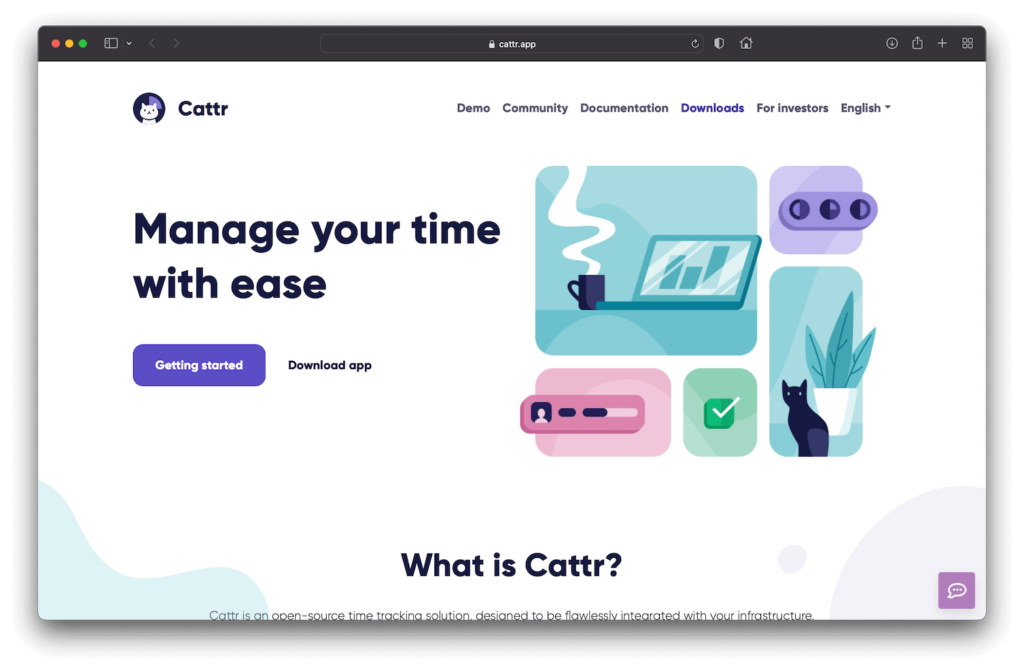
Are you tired of playing the endless game of chasing down employee timesheets? Are you looking for a solution that seamlessly integrates with your current infrastructure? Look no further than Cattr, the open-source time-tracking tool. With features like screenshot capture and automatic activity detection, tracking and monitoring employee productivity is easy. And best of all, it’s designed to work flawlessly with your existing software. Say goodbye to manual time tracking and say hello to improved team performance with Cattr.
Key Features:
- Open Source
With open source content, not only is the community version available for free, but it also allows for transparency and collaboration within the community to constantly improve and innovate the product. Additionally, as it is under the SSPL license, it guarantees that it will always remain free and open source
- Activity tracking
When it comes to activity tracking, this feature allows for increased productivity within a company by providing insight into how each individual or team focuses their time and effort during their workflow. This can lead to identifying areas of improvement or potential distractions, ultimately allowing for a more streamlined and efficient process.
- On-premises
Having an on-premises option means that all of a company’s private data can be securely stored within its infrastructure. This provides peace of mind in terms of data protection regulations and offers more control over server management and customization options.
- Extensions
The option for extensions allows for even further customization of the product through community plugins or even creating your own. This adds to the flexibility and adaptability of the software to fit the specific needs and requirements of a company or organization.
The MongoDB Server Side Public License (SSPL) applies to Cattr and grants users the ability to use, modify, and distribute the software. However, if any changes are made to the software, they must be distributed under the SSPL. Additionally, if the software is used to provide a service, the service must also be made available under the SSPL.
MongoDB created this license in response to concerns about companies using open-source software to provide a service without contributing back to the community. By requiring that any services using their open source software also be released under an open source license, MongoDB aims to create a more equitable ecosystem for open source development.
2. OpenProject
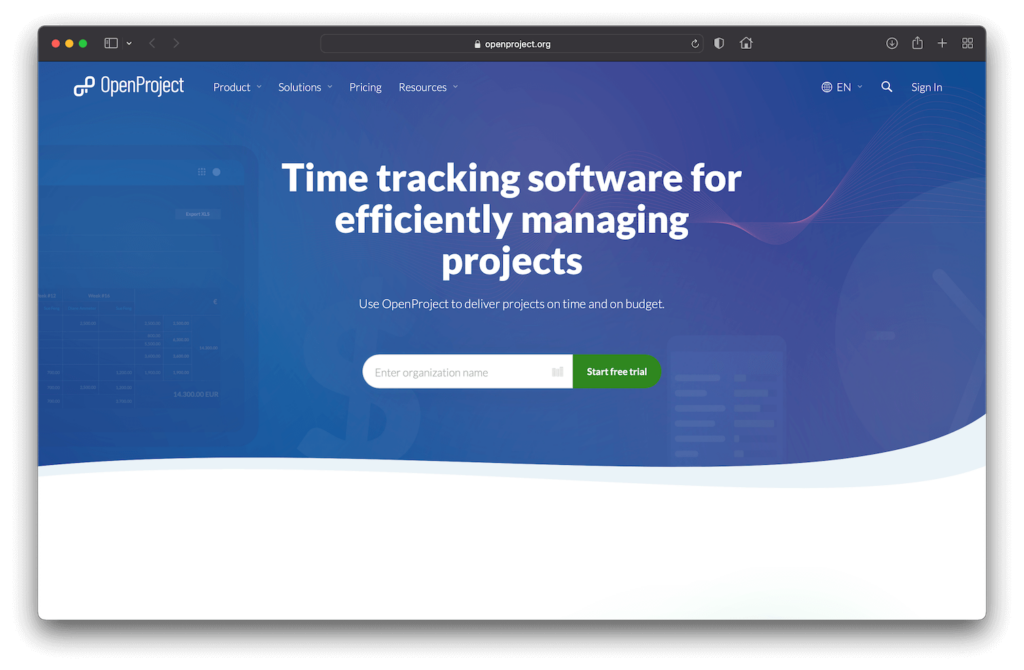
Looking for a way to keep your team organized and on track with their projects? Look no further than OpenProject, a versatile project management software. In addition to allowing team members to track their hours against specific tasks, it also includes a Gantt chart module and productivity reporting features. This makes it easy to plan out project timelines and track progress. And with its agile methodology support and in-built employee scheduling capabilities, OpenProject can streamline your team’s workflow and boost overall efficiency.
Key Features:
- The manual time tracking feature allows you to easily log the specific hours you worked on each project or task for the day or week. This allows for more accurate record-keeping and billing and provides helpful information for analyzing productivity and efficiency.
- The ability to assign different hourly rates for team members, projects, and time frames allow for more precise and customized cost reporting. This can also help with budgeting and project planning.
- The expense tracking feature helps keep track of any related costs for a project or task, providing valuable information for overall cost analysis and reporting.
- The productivity reports can be exported in a CSV format, making it easy to integrate with other systems or share with clients or team members. This helps with communication and collaboration.
OpenProject offers the premium features of boards for both their cloud and on-premises Enterprise editions. For those who want to host the software on their server. Those who have already installed the Community edition can request a free 14-day trial license to test out the Enterprise on-premises edition before purchasing. These premium features can enhance project management and collaboration efforts within teams.
3. Redmine
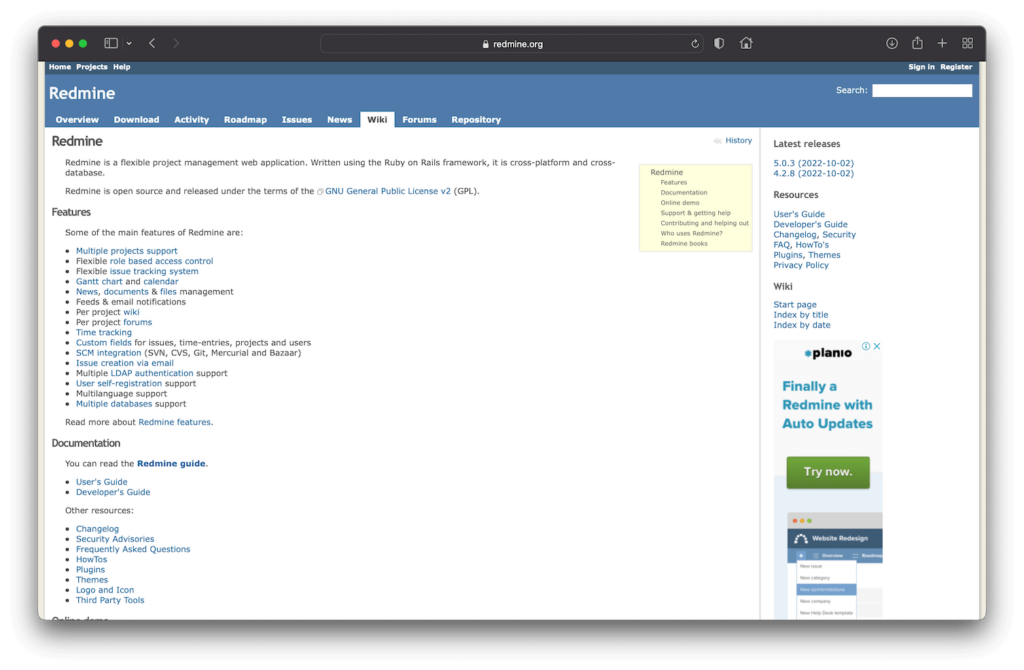
If you’re looking for a comprehensive project management tool, look no further than Redmine. This versatile web application offers issues tracking, wiki collaboration, a calendar and Gantt chart, and time-tracking capabilities.
Thanks to its open source build and flexible design, it can easily be customized to fit the needs of any team or organization. Redmine also integrates with various other tools and software, making it easy to consolidate all your project management tasks into one convenient platform. So if you’re looking for a reliable and customizable solution, give Redmine a try.
Key Features
- With the manual time logging feature, employees can easily track and record the amount of time spent on a specific task. This information can then be used for project planning and budgeting, as well as invoicing clients for billable hours.
- The permission settings allow for customizable access levels within the team, ensuring that only those with the appropriate authority are able to make changes to sensitive project information.
- The task estimating and budgeting capabilities enable project managers to allocate resources and keep projects on track efficiently. This can also aid in decision making and identifying potential issues before they arise.
- The ability to calculate billable hours for each employee allows for more accurate invoicing of clients and provides insight into individual productivity levels within the team.
The license type for the Redmine software is open source, meaning that anyone can access and modify it. This type of license allows a collaborative community to contribute to and improve the software, resulting in constantly evolving and improving features. Additionally, using open source software often results in cost savings for businesses and organizations as they do not have to purchase expensive licenses.
However, it is essential to note that while the software may be open source, any plugins or add-ons developed for Redmine may have individual licenses. Overall, using open source software such as Redmine allows for a more transparent and collaborative approach to project management.
Simple online time tracking tool your team will love. Free for small teams.
No surprise invoices. No per-user fees. No credit card required.
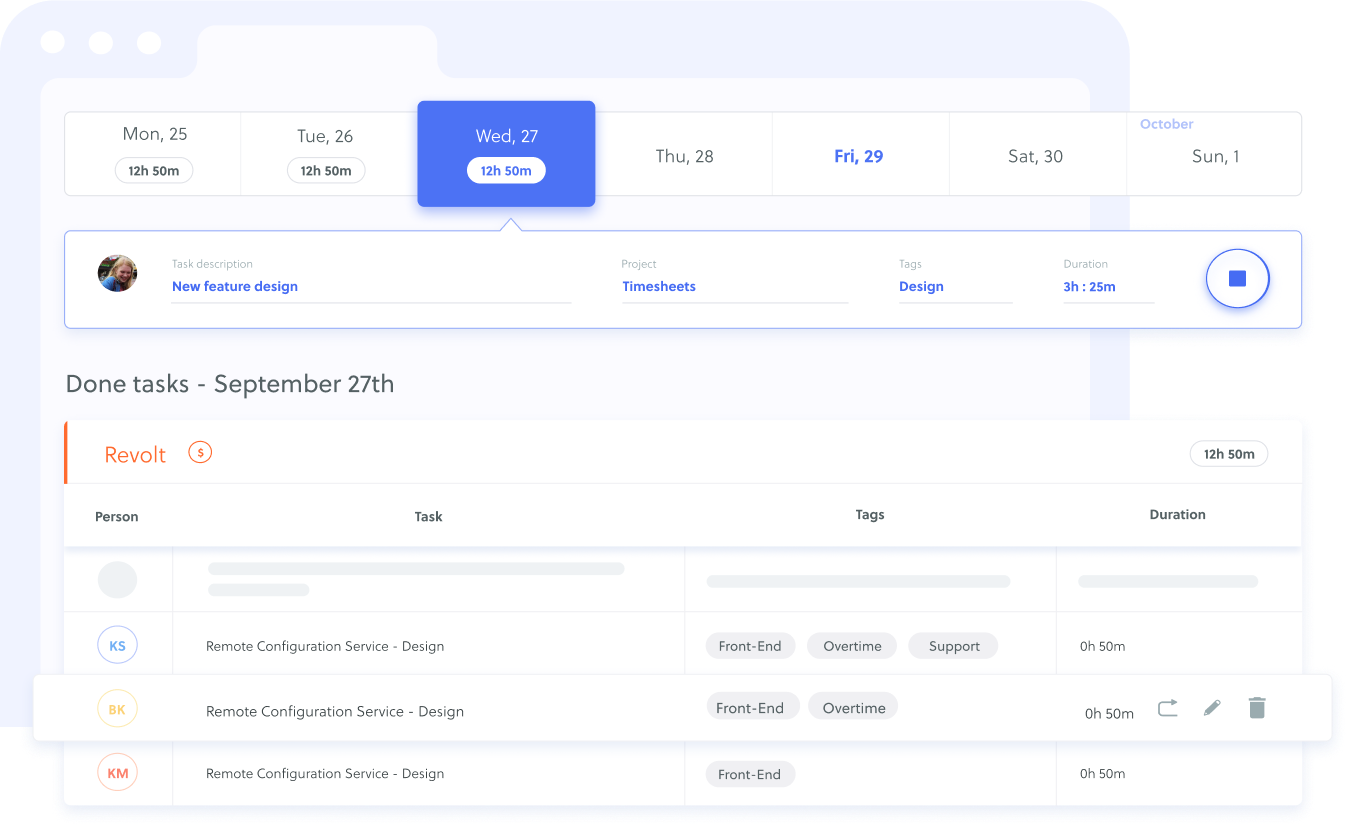
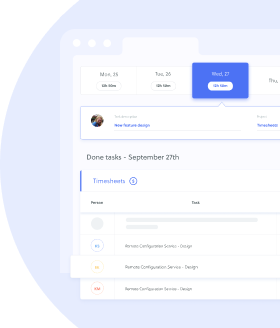
4. Pendulums
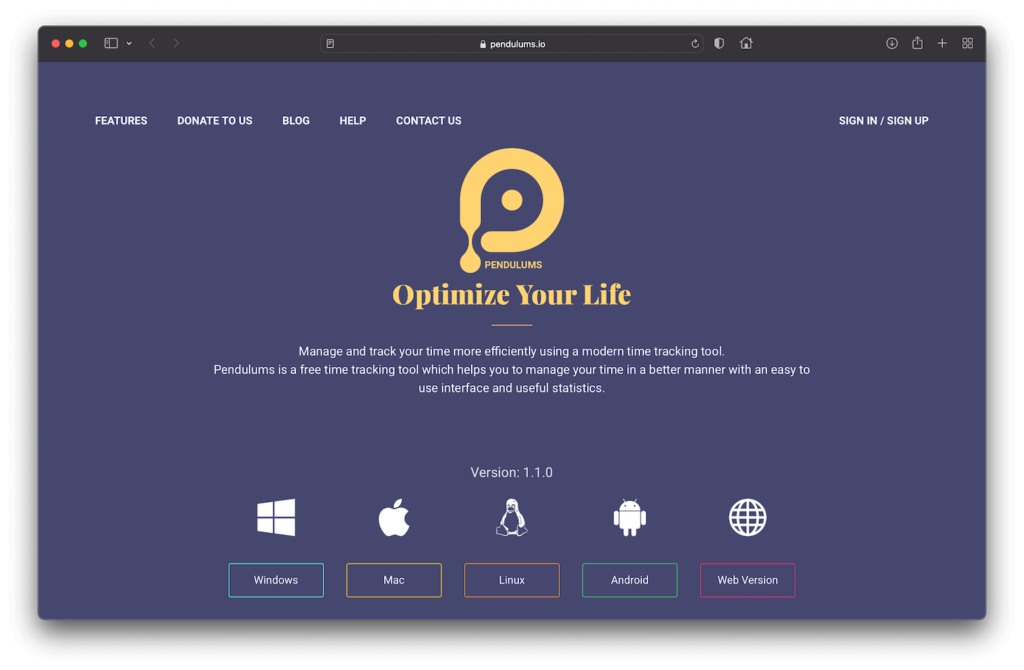
Staying on top of your time management is crucial for productivity and success. When it comes to managing and tracking your time, one tool that can be extremely helpful is a modern time tracking tool. Pendulums offers just that, with a user-friendly interface and helpful statistics. With the ability to track multiple projects at once and create customized tags, you’ll better understand where your time is being spent.
With the option to generate organized reports, sharing and reviewing your progress with others is easy. So why not try out this free tool and see how it can help improve your time management skills? It may just make all the difference in reaching your goals.
Key Features:
- Unlimited Projects
With unlimited projects, users can easily keep track of all their work and stay organized without having to worry about hitting any limits. This also allows for flexibility in case a user wants to start a new project or experiment with different ideas.
- User Friendly Charts And Reports
The user friendly charts and reports make it easy for users to analyze their team’s performance and project progress. These features also allow for efficient planning and decision making.
- Unlimited Team Members
Inviting unlimited team members also adds to the flexibility and potential for collaboration within a project. It also allows for a larger pool of resources and expertise to be tapped into for success.
- Unlimited Notes
In Pendulums, users can take unlimited notes and tag them for specific projects. This allows for easy organization and access to important information, such as ideas, to-do lists, and code snippets. Having all of this information in one place also helps increase productivity by eliminating the need to switch between multiple apps or search through multiple sources for necessary information.
- Rest Time Reminder
In addition to organizing work-related tasks and information, Pendulums also offers a rest time reminder feature. The importance of adequate rest cannot be overstated – without it, our health suffers and our productivity decreases. With this feature, users can set notification intervals based on either standard presets or their own customized preferences. By reminding users to take breaks and prioritize rest, Pendulums promotes both physical and mental well-being.
The Pendulums app uses the MIT License, which allows for the free use, modification, and distribution of the software as long as the original copyright and permission notices are included. This type of open-source license also does not place any restrictions on how the software can be used or who can use it.
In addition, the MIT License does not hold liable those who use or distribute the software. This allows individuals and companies to feel secure in using and sharing the Pendulums app without fear of legal repercussions.
Overall, the MIT License gives developers and users a large amount of freedom and flexibility in their usage of the Pendulums app.
5. Kimai
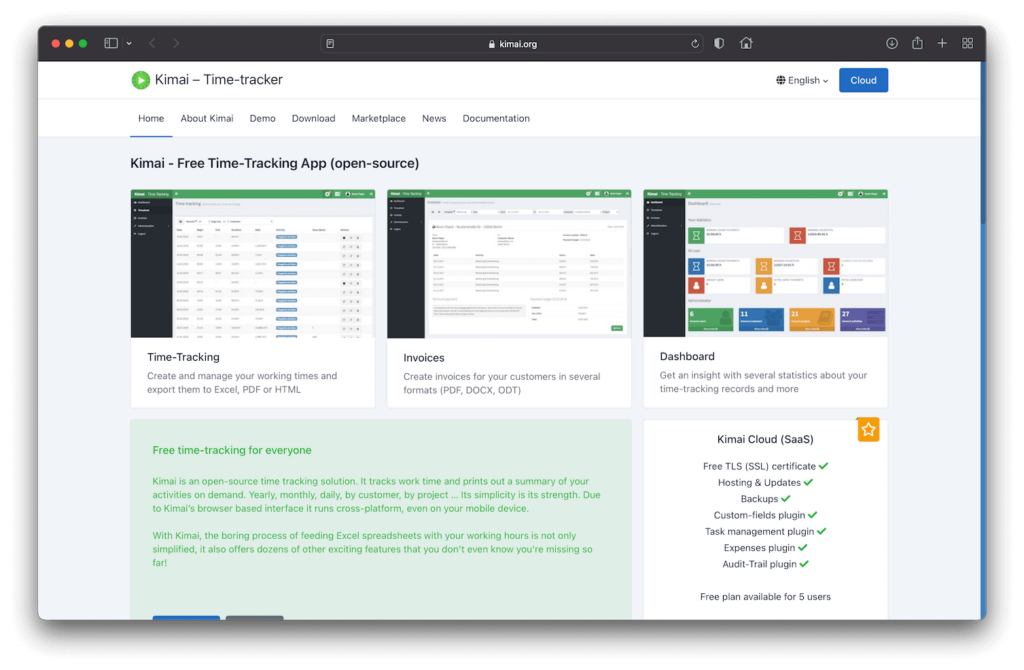
Launched in 2006, Kimai has a long history of providing an efficient and reliable time tracking solution. With consistent maintenance and improvements by its team, it offers numerous features to suit the needs of a variety of users.
Not only does it support an unlimited number of users and timesheet entries, but it also has a responsive design for easy access on mobile devices. Whether for personal or business use, Kimai’s extensive features make it a go-to option for tracking one’s working hours.
Key Features:
- Mobile readiness:
The layout of Kimai can adapt to any device, ensuring users have easy access no matter what technology they use. Additionally, users can customize which data columns are displayed, helping to prevent excessive scrolling on smaller screens.
- Plugins:
Kimai allows for extended functionality through the use of plugins. These can be easily integrated into the system and offer a wide range of possibilities for customization.
- Multi-user:
There is no limit to the number of users that can access and utilize Kimai. Each user can also be assigned specific roles and permissions within the software.
- Multi-language:
Kimai has been translated into more than 30 languages, allowing for global usage and accessibility.
- Teams:
Users can be organized into teams based on departments or project groups. Both customers and projects can then be assigned to these teams for better organization and collaboration.
One of the major benefits of using Kimai is that it is completely open source, meaning the source code is available for anyone to view, modify, and improve upon. This also means that there are no licensing fees or restrictions on its use.
This allows small businesses and individuals to use it without worrying about the cost, and also allows for a community of developers to constantly improve and update the software. Additionally, open source software often has greater security because it allows for a larger number of eyes to identify and fix any potential vulnerabilities.
6. ActivityWatch
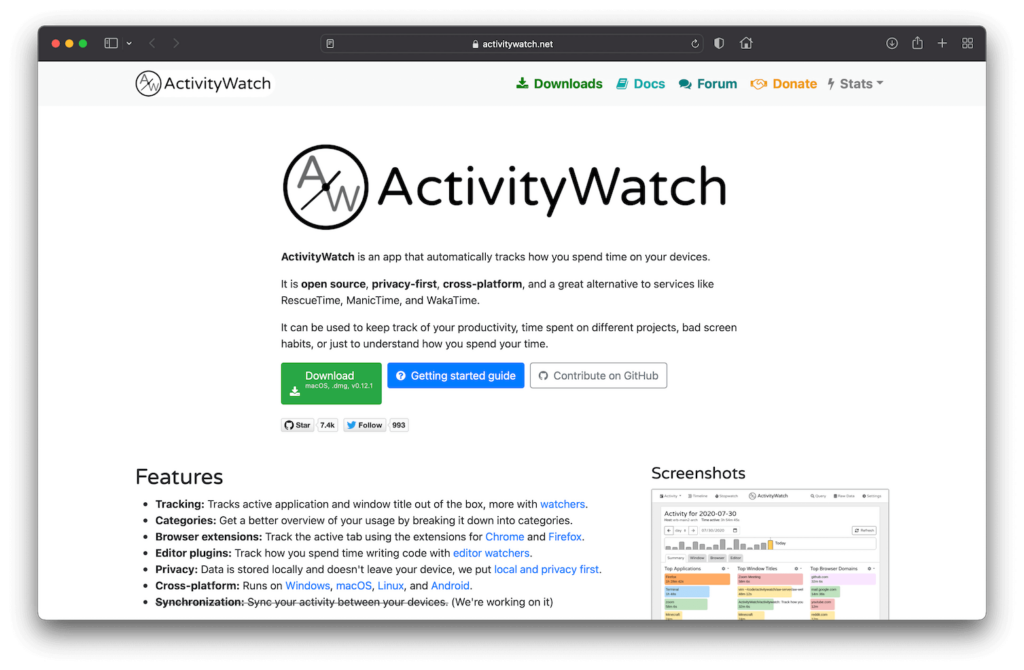
ActivityWatch is a open source, privacy-focused app that automatically tracks your usage across all devices, providing insights into productivity, time management, and even potential screen addiction. Unlike similar services like RescueTime and ManicTime, ActivityWatch offers cross-platform tracking and complete control over your data.
In addition to tracking time spent on specific applications or websites, ActivityWatch also records keystrokes and mouse clicks to provide a more comprehensive overview of daily activity. Users can set up custom tags for specific projects or tasks, allowing for granular analysis of time allocation.
For individuals looking to optimize their workflow and improve productivity, ActivityWatch offers valuable insights and data. Its ability to track usage across multiple devices also allows for better understanding of screen time habits and potential technology addiction.
By giving users complete control over their data and offering a unique combination of features, ActivityWatch provides a valuable resource for improving how we spend our time on digital devices.
Key Features:
- Tracking:
Not only does the time tracker software track the active application and window title, but it also allows users to set up “watchers” to track specific tasks or projects. This gives them even more detailed insights into how they are spending their time.
- Categories:
Users can categorize their tracked time, which gives them a better understanding of where their time is being spent. For example, they may have a category for work tasks, personal tasks, and leisure activities.
- Browser extensions:
The time tracker has extensions for both Chrome and Firefox that allow users to track the active tab in their browser. This adds even more detail to their overall tracking.
- Editor plugins:
For those who primarily write code, the time tracker offers “editor watchers” that track their activity in different code editors. This helps them understand how much time they are spending on each project or task within their editor.
- Privacy:
The time tracker stores all data locally on the user’s device, ensuring that it never leaves their control or is shared with anyone else without their consent. Privacy is a top priority for the software.
- Cross-platform:
The time tracker can be used on Windows, macOS, Linux, and Android devices, allowing users to track their time no matter what type of device they are using.
ActivityWatch is licensed under the GNU General Public License (GPL) version 3. This license allows users to freely distribute, modify, and improve the software as long as any derivative works are also distributed under the same license. It ensures that the software remains open and accessible for everyone to use and improve upon.
Additionally, the GPL promotes collaboration and sharing within the software community by requiring that any changes or improvements made to the source code are publicly shared. This helps to drive further innovation and development of the software.
7. TimeTrex
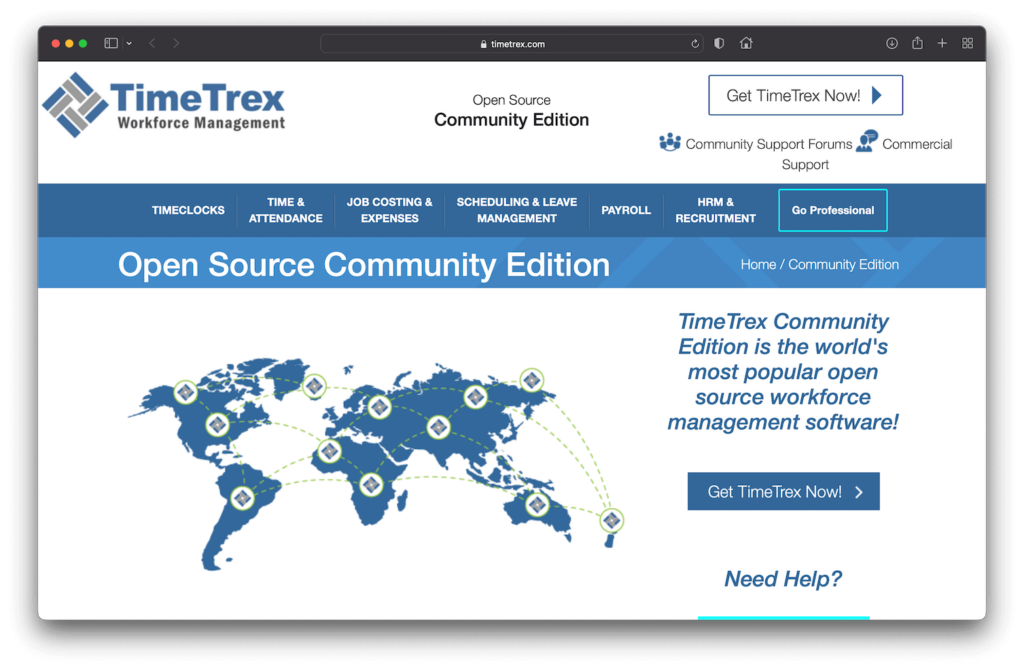
Have you ever felt like time just slips through your fingers and you can never seem to keep track of where it all went? That’s where TimeTrex Open Source Community Edition comes in. Developed and supported by a network of volunteers spanning over 50 countries, this time-tracking tool helps you stay on top of your schedule and make the most out of every minute.
No longer will minutes turn into hours, or hours into days wasted. Say goodbye to time slipping away and hello to improving productivity with TimeTrex Open Source Community Edition!
TimeTrex is not only a time-tracking app, but it also provides a wide range of functions for managing projects.
Key Features:
- TimeClocks:
This feature allows employees to clock in and out for their shifts, ensuring accurate record keeping of hours worked. It can also track break times and calculate the total time on the clock for each shift. In addition, some timeclock systems offer the ability to utilize biometric data, such as fingerprint scanning, further to ensure the accuracy and security of employee time tracking.
- Scheduling:
This feature allows managers to easily create and edit employee schedules, taking into account any requested time off or shift preferences. It can also send out schedule notifications to employees and allow them to swap shifts with each other if needed. Some scheduling systems even have the capability to forecast labor needs based on historical data and projected business volume.
- Time & Attendance:
In addition to tracking when employees clock in and out, this feature can also track paid time off (PTO), vacation days, sick leave, and other forms of approved absences. It can generate reports on overall attendance patterns for individuals or the entire workforce.
- Job Costing:
This feature allows businesses to track the expenses associated with specific jobs or projects, making it easier to bill clients and manage profits accurately. It can integrate with time & attendance data to calculate labor costs for each job.
- Document Management:
This feature provides a centralized location for storing important HR-related documents such as employee contracts, performance reviews, training materials, benefits information, and more. It allows for easy access and organization of these documents by both HR staff and employees.
The license type for TimeTrex is an open source, GNU General Public License (GPL) version 3. This means that the source code for the software is freely available and can be modified or redistributed by anyone in accordance with the terms outlined in the GPL. Overall, TimeTrex offers a comprehensive suite of tools for managing a company’s human resources and time-based operations.
8. Anuko
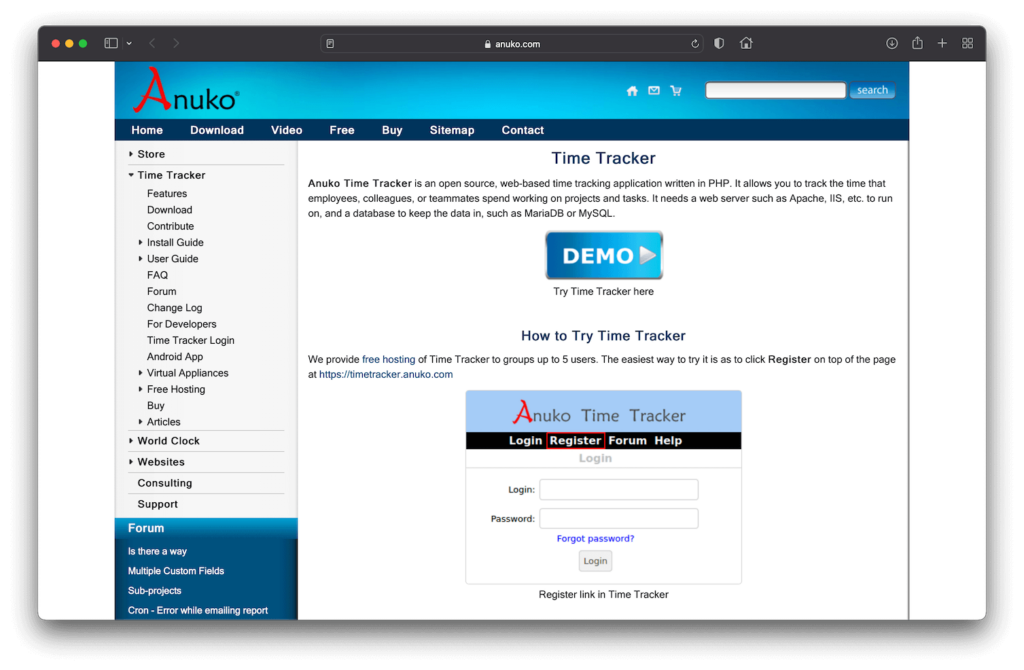
Anuko Time Tracker streamlines the task of keeping track of time spent on various projects, making it easy for managers and team leaders to monitor and analyze employee productivity. The open source nature of the application allows for customizability and integration with other systems, potentially improving efficiency even further. In order to use Anuko Time Tracker, a web server and database are required, such as Apache and MariaDB.
Users can access the application through a web browser, making it convenient for remote teams or employees who work from home. Overall, Anuko Time Tracker offers an efficient solution for monitoring time spent on tasks and projects.
Key Features:
- Free Time Tracker
- Easy to Use
- Open Source
- Suitable for Small and Large Organizations
- Virtual Appliances
- User Roles
- Time Input
- Flexible Reports
- Multiple Localizations
- Plugins
- Export / Import
- Technical Support
Anuko Time Tracker prides itself on being a customizable and user-friendly tool for managing time and productivity. As an open source project, it welcomes customization requests from the community that can be integrated into the existing program for the benefit of all users. However, if your request is too specific to your own unique needs, hire a freelance PHP developer to make those changes for you.
9. eHour
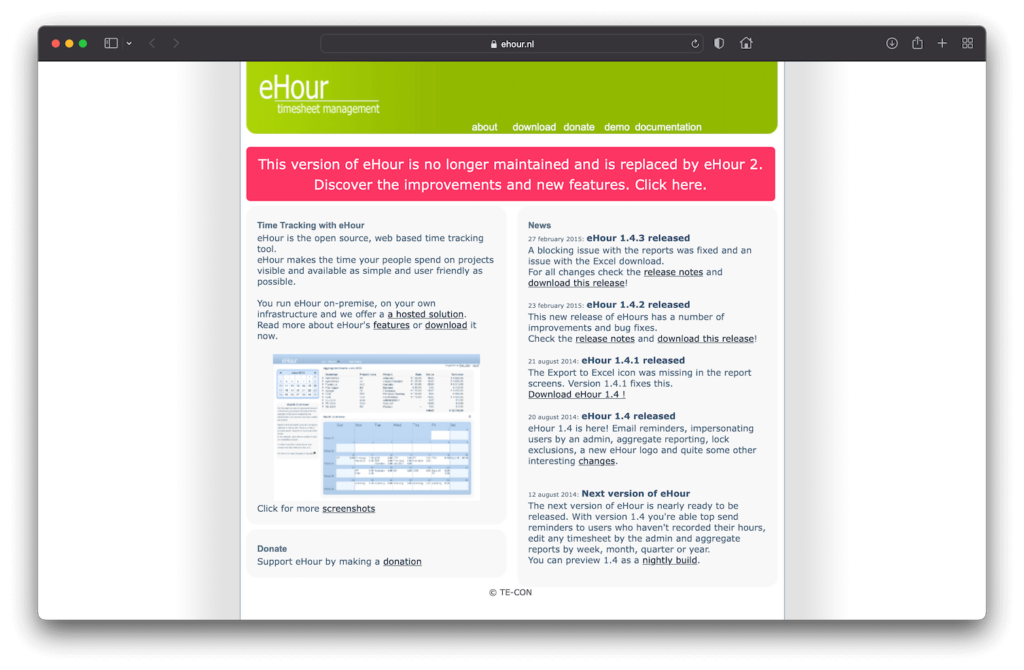
eHour is the perfect solution for companies looking for a simple and efficient way to track employee time. The software is open source and can be run on-premise or through a hosted solution. eHour’s user-friendly interface ensures that all members of the team can easily log their time, making it easy for managers to see how much time has been spent on each project.
By providing visibility into how employees are spending their time, eHour helps companies optimize resource allocation and improve overall productivity. Whether your company prefers to use its own infrastructure or utilize a hosted solution, eHour offers a reliable option for time tracking.
Key Features:
1. The ability to create multiple projects per customer allows for more efficient organization and tracking of work hours. It also allows for the assignment of multiple users to a single project, increasing collaboration and communication within teams.
2. Setting up default projects, such as for days off or sick leave, helps to accurately track and report on all employee hours worked.
3. The reporting feature provides extensive and customizable information on project progress and employee time allocation.
4. eHour offers configurable localization and currency options, making it accessible and useful for a global workforce. It is currently available in six different languages.
5. The platform allows for the separation of roles, including user, project manager, reporting manager, and administrator, ensuring that each team member has access to only the information relevant to their job function.
6. Timesheets can be locked to prevent any unauthorized changes or alterations to recorded hours worked.
7. Reports can be easily exported into Excel for further analysis and sharing with colleagues or clients.
8. Automatic email reminders help maintain accountability and ensure timely submission of timesheets.
9. The web-based user interface eliminates the need for software installation on individual desktop computers.
10. With an on-premise installation option, users have full control over their data security and privacy.
eHour, a software for tracking employee time, is available for use under the open source license, GPL v2. This means that individuals and companies are free to download, modify, and redistribute the software according to their needs. Not only does this provide flexibility for users, but it also ensures transparency and accountability as all changes made to the program are publicly available. eHour’s commitment to open source allows for collaboration and improvement from a community of users, making it a continuously evolving tool for employee time tracking.
10. TimeClockMTS
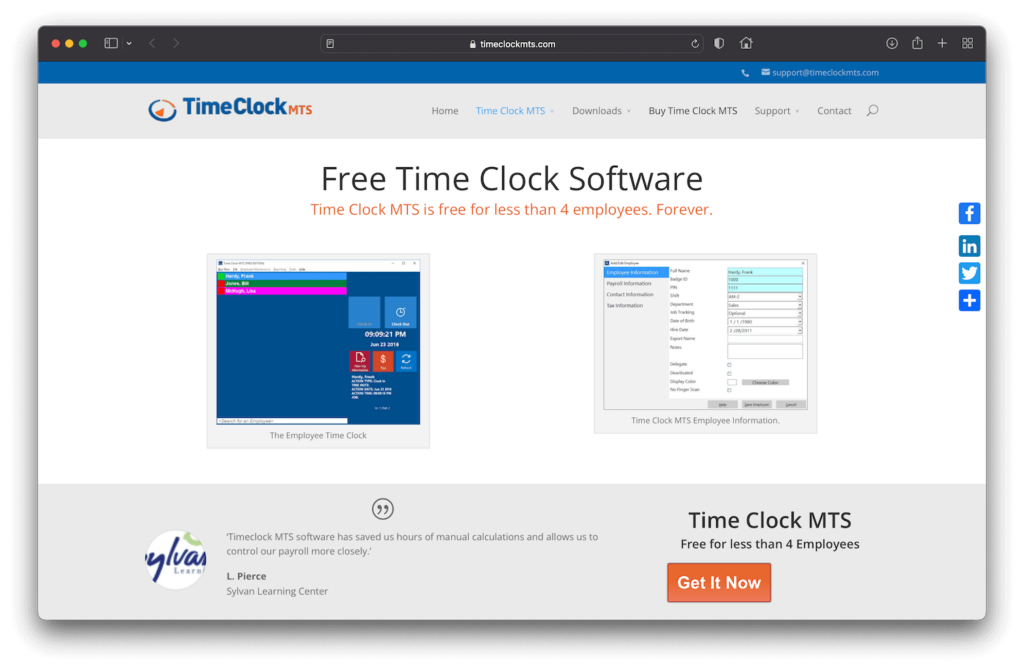
Hourglass is a simple yet comprehensive solution for time and expense tracking and task management. This highly flexible and scalable web-based application allows you to track employee, client, project, rate, and workload information all in one place. In addition to its user-friendly interface, Hourglass also provides numerous time, task, expense, project, and billing reports to help increase efficiency and transparency in team management. Say goodbye to scattered spreadsheets and missed deadlines with Hourglass’ reliable and all-inclusive solution.
Key Features:
- Accurate time tracking and record keeping
Detailed timesheet entries not only provide transparency for both employer and employee, but they can also lead to increased accuracy in payroll and billing processes. Additionally, having a clear record of hours worked can aid in project planning and resource allocation.
- User-friendly interface
An intuitive interface not only allows for easy adoption and use by employees, but it can also lead to higher compliance rates in properly recording and submitting time. This can result in improved efficiency and cost savings for the organization.
- Enhanced reporting capabilities
Robust reporting capabilities allow for greater accountability and insight into productivity levels both individually and as a team. This can aid in identifying areas for improvement and maximizing the use of resources.
- Real-time updates
Real-time updates via a web-based platform can help capture any lost or forgotten time, leading to more accurate records and potentially recapturing revenue.
- Automated email reminders
Automated email reminders ensure that timesheets are submitted on time and aid in staying organized, allowing the business to run more smoothly.
Conclusion
So there you have it, our list of the best free open source time tracking software. Did your favorite make the list? If not, be sure to let us know in the comments so we can check it out for future iterations of this post. And if you’re looking for a comprehensive time tracking solution that doesn’t break the bank, be sure to check out Quidlo. We offer a variety of plans that will fit any budget, and all of our features are available on both our desktop and mobile apps. Thanks for reading!
21

